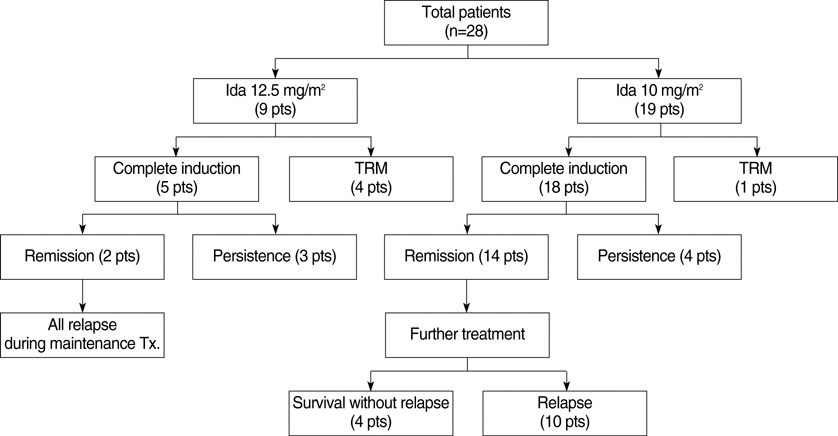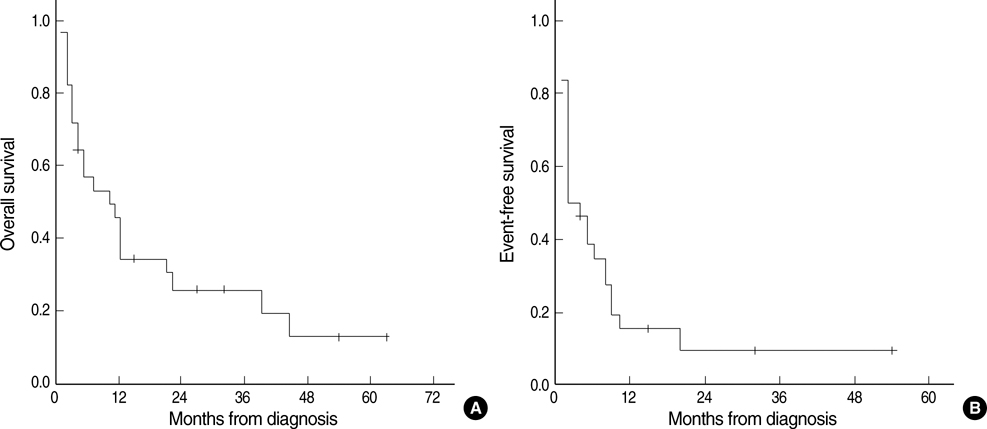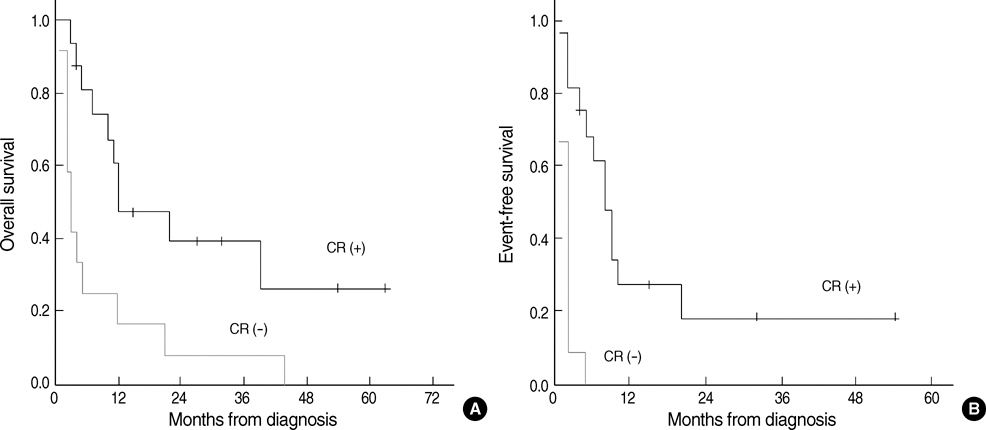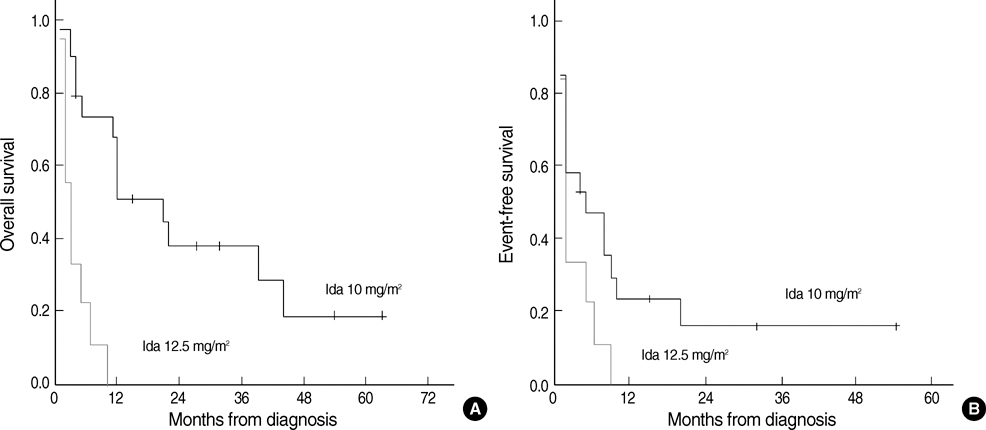J Korean Med Sci.
2009 Apr;24(2):281-288. 10.3346/jkms.2009.24.2.281.
Improvement of Induction Remission Rate by Modifying the Dose of Idarubicin for Relapsed Childhood Acute Lymphoblastic Leukemia
- Affiliations
-
- 1Department of Pediatrics, Cancer Research Institute, Seoul National University College of Medicine, Seoul, Korea. hsahn@snu.ac.kr
- KMID: 1779131
- DOI: http://doi.org/10.3346/jkms.2009.24.2.281
Abstract
- Relapse is the major cause of treatment failure in acute lymphoblastic leukemia (ALL), yet there is no established treatment for relapsed ALL. To improve the induction remission rate, we modified the dose of idarubicin in the original Children's Cancer Group (CCG)-1884 protocol, and retrospectively compared the results. Twenty-eight patients diagnosed with relapsed ALL received induction chemotherapy according to the CCG-1884 protocol. Complete remission (CR) rate in all patients after induction chemotherapy was 57%. The idarubicin 10 mg/m2/week group showed CR rate of 74%, compared with the 22% CR rate of the idarubicin 12.5 mg/m2/week group (p=0.010). Remission failure due to treatment-related mortality (TRM) was 44% and 5.2% in the idarubicin 12.5 mg/m2/week and 10 mg/m2/week groups, respectively (p=0.011). Overall survival (OS) and 4-yr event-free survival (EFS) were 12.8% and 10.3%, respectively. OS and 4-yr EFS were higher in the idarubicin 10 mg/m2/week group (19.3% and 15.6%) than in the 12.5 mg/m2/week group (0% and 0%). In conclusion, a modified dose of idarubicin from 12.5 mg/m2/week to 10 mg/m2/week resulted in an improved CR rate in the treatment of relapsed ALL, which was due to lower TRM. However, despite improved CR rate with modified dose of idarubicin, survival rates were unsatisfactory.
MeSH Terms
-
Adolescent
Antineoplastic Combined Chemotherapy Protocols/*administration & dosage
Child
Child, Preschool
Disease-Free Survival
Female
Humans
Idarubicin/*administration & dosage
Infant
Male
Precursor Cell Lymphoblastic Leukemia-Lymphoma/*drug therapy/mortality
Recurrence
Remission Induction
Retrospective Studies
Survival Rate
Figure
Reference
-
1. Chessells JM. Relapsed lymphoblastic leukemia in children: a continuing challenge. Br J Haematol. 1998. 102:423–438.2. Gaynon PS, Qu RP, Chappell RJ, Willoughby ML, Tubergen DG, Steinherz PG, Trigg ME. Survival after relapse in childhood acute lymphoblastic leukemia: impact of site and time to first relapse- the Children's Cancer Group Experience. Cancer. 1998. 82:1387–1395.3. Weiss MA, Aliff TB, Tallman MS, Frankel SR, Kalaycio ME, Maslak PG, Jurcic JG, Scheinberg DA, Roma TE. A Single, high dose of idarubicin combined with cytarabine as induction therapy for adult patients with recurrent or refractory acute lymphoblastic leukemia. Cancer. 2002. 95:581–587.
Article4. Thomson B, Park JR, Felgenhauer J, Meshinchi S, Holcenberg J, Geyer JR, Avramis V, Douglas JG, Loken MR, Hawkins DS. Toxicity and efficacy of intensive chemotherapy for children with acute lymphoblastic leukemia (ALL) after first bone marrow or extramedullary relapse. Pediatr Blood Cancer. 2004. 43:571–579.
Article5. Reaman GH, Ladisch S, Echelberger C, Poplack DG. Improved treatment results in the management of single and multiple relapses of acute lymphoblastic leukemia. Cancer. 1980. 45:3090–3094.
Article6. Rivera GK, Buchanan G, Boyett JM, Camitta B, Ochs J, Kalwinsky D, Amylon M, Vietti TJ, Crist WM. Intensive treatment of childhood acute lymphoblastic leukemia in the first bone marrow relapse: a Pediatric Oncology Group Study. N Engl J Med. 1986. 315:273–278.7. Buchanan GR, Rivera GK, Boyett JM, Chauvenet AR, Crist WM, Vietti TJ. Reinduction therapy in 297 children with acute lymphoblastic leukemia in first bone marrow relapse: a Pediatric Oncology Group Study. Blood. 1988. 72:1286–1292.
Article8. Vogler WR, Velez-Garcia E, Weiner RS, Flaum MA, Bartolucci AA, Omura GA, Gerber MC, Banks PL. A phase III trial comparing idarubicin and daunorubicin in combination with cytarabine in acute myelogenous leukemia: a Southeastern Cancer Study Group study. J Clin Oncol. 1992. 10:1103–1111.
Article9. Berman E, Heller G, Santorsa J, McKenzie S, Gee T, Kempin S, Gulati S, Andreeff M, Kolitz J, Gabrilove J, Reich L, Mayer K, Keefe D, Trainor K, Schluger A, Penenberg D, Raymond V, O'Reilly R, Jhanwar S, Young C, Clarkson B. Results of a randomized trial comparing idarubicin and cytosine arabinoside with duanorubicin and cytosine arabinoside in adults patients with newly diagnosed acute myelogenous leukemia. Blood. 1991. 77:1666–1674.10. Wiernik PH, Banks PL, Case DC Jr, Arlin ZA, Periman PO, Todd MB, Ritch PS, Enck RE, Weitberg AB. Cytarabine plus idarubicin or daunorubicin as induction and consolidation therapy for previously untreated adult patients with acute myeloid leukemia. Blood. 1992. 79:313–319.
Article11. Casazza AM, Pratesi G, Giuliani F, Di Marco A. Antileukemic activity of 4-demethoxydaunorubicin in mice. Tumori. 1980. 66:549–564.
Article12. Reid JM, Pendergrass TW, Krailo MD, Hammond GD, Ames MM. Plasma pharmacokinetics and cerebrospinal fluid concentrations of idarubicin and idarubicinol in pediatric leukemia patients: a Children's Cancer Study Group report. Cancer Res. 1990. 50:6525–6528.13. Tan CT, Hancock C, Steinherz P, Bacha DM, Steinherz L, Luks E, Winick N, Meyers P, Mondora A, Dantis E, Niedzwiecki D, Stevens TW. Phase I and clinical pharmacological study of 4-demethoxydaunorubicin (idarubicin) in children with advanced cancer. Cancer Res. 1987. 47:2990–2995.14. Feig SA, Krailo MD, Harris RE, Baum E, Holcenberg JS, Kaizer H, Steinherz L, Pendergrass TW, Saunders EF, Warkentin PL, Bleyer WA, Hammond GD. Determination of the maximum tolerated dose of idarubicin when used in a combination chemotherapy program of reinduction of childhood ALL at first marrow relapse and a preliminary assessment of toxicity compared to that of daunorubicin: a report from the Children's Cancer Study Group. Med Pediatr Oncol. 1992. 20:124–129.
Article15. Feig SA, Ames MM, Sather HN, Steinherz L, Reid JM, Trigg M, Pendergrass TW, Warkentin P, Gerber M, Leonard M, Bleyer WA, Harris RE. Comparison of idarubicin to daunomycin in a randomized multidrug treatment of childhood acute lymphoblastic leukemia at first bone marrow relapse: a report from the Children's Cancer Group. Med Pediatr Oncol. 1996. 27:505–514.
Article16. Rocha JC, Cheng C, Liu W, Kishi S, Das S, Cook EH, Sandlund JT, Rubnitz J, Ribeiro R, Campana D, Pui CH, Evans WE, Relling MV. Pharmacogenetics of outcome in children with acute lymphoblastic leukemia. Blood. 2005. 105:4752–4758.
Article17. Shimasaki N, Mori T, Samejima H, Sato R, Shimada H, Yahagi N, Torii C, Yoshihara H, Tanigawara Y, Takahashi T, Kosaki K. Effects of methylenetetrahydrofolate reductase and reduced folate carrier 1 polymorphisms on high-dose methotrexate-induced toxicities in children with acute lymphoblastic leukemia or lymphoma. J Pediatr Hematol Oncol. 2006. 28:64–68.
Article18. Kager L, Evans WE. Pharmacogenomics of acute lymphoblastic leukemia. Curr Opin Hematol. 2006. 13:260–265.
Article19. Giona F, Testi AM, Rondelli R, Amadori S, Arcese W, Meloni G, Moleti ML, Ceci A, Pillon M, Madon E, Comis M, Pession A, Mandelli F. ALL R-87 protocol in the treatment of children with acute lymphoblastic leukemia in early bone marrow relapse. Br J Haematol. 1997. 99:671–677.20. Testi AM, Del Giudice I, Arcese W, Moleti ML, Giona F, Basso G, Biondi A, Conter V, Messina C, Rondelli R, Micozzi A, Micalizzi C, Barisone E, Locatelli F, Dini G, Aricò M, Casale F, Comis M, Ladogana S, Lippi A, Mura R, Pinta MF, Santoro N, Valsecchi MG, Masera G, Mandelli F. AIEOP Cooperative Group. A single high dose of idarubicin combined with high-dose Ara-C for treatment of first relapse in childhood 'high-risk' acute lymphoblastic leukemia: a study of the AIEOP group. Br J Haematol. 2002. 118:741–747.21. Leahey AM, Bunin NJ, Belasco JB, Meek R, Scher C, Lange BJ. Novel multiagent chemotherapy for bone marrow relapse of pediatric acute lymphoblastic leukemia. Med Pediatr Oncol. 2000. 34:313–318.
Article22. Johnson FL, Thomas ED, Clark BS, Chard RL, Hartmann JR, Storb R. A comparison of marrow transplantation with chemotherapy for children with acute lymphoblastic leukemia in second or subsequent remission. N Engl J Med. 1981. 305:846–851.
Article23. Dopfer R, Henze G, Bender-Götze C, Ebell W, Ehninger G, Friedrich W, Gadner H, Klingebiel T, Peters C, Riehm H, Suttorp M, Schmid H, Schmitz N, Siegert W, Stollmann-Gibbels B, Hartmann R, Niethammer D. Allogeneic bone marrow transplantation for childhood acute lymphoblastic leukemia in second remission after intensive primary and relapse therapy according to the BFM- and CoALL-protocols: results of the German Cooperative study. Blood. 1991. 78:2780–2784.
Article24. Uderzo C, Valsecchi MG, Bacigalupo A, Meloni G, Messina C, Polchi P, Di Girolamo G, Dini G, Miniero R, Locatelli F. Treatment of childhood acute lymphoblastic leukemia in second remission with allogenic bone marrow transplantation and chemotherapy: ten-year experience of the Italian Bone Marrow Transplantation Group and the Italian Pediatric Hematology Oncology Group Association. J Clin Oncol. 1995. 13:352–358.25. Sanders JE, Thomas ED, Buckner CD, Doney K. Marrow transplantation for children with acute lymphoblastic leukemia in second remission. Blood. 1987. 70:324–326.
Article26. Feig SA, Harris RE, Sather HN. Bone marrow transplantation versus chemotherapy for maintenance of second remission of childhood acute lymphoblastic leukemia: a study of the Children's Cancer Group (CCG-1884). Med Pediatr Oncol. 1997. 29:534–540.
Article27. Kang HJ, Shin HY, Ahn HS. Acute lymphoblastic leukemia in children: past, present and future. Korean J Pediatr. 2007. 50:601–605.
Article
- Full Text Links
- Actions
-
Cited
- CITED
-
- Close
- Share
- Similar articles
-
- Outcome of Reinduction Chemotherapy with a Modified Dose of Idarubicin for Children with Marrow-Relapsed Acute Lymphoblastic Leukemia: Results of the Childhood Acute Lymphoblastic Leukemia (CALL)-0603 Study
- Effect of peripheral blood cell counts during remission induction and maintenance therapy on the prognosis and therapy of childhood acute lymphoblastic leukemia
- Ifosfamide and Etoposide in Relapsed Refractory Childhood Acute Lymphoblastic Leukemia
- Low-dose All-trans Retinoic Acid for Remission Induction of Acute Promyelocytic Leukemia in Acute Renal Failure
- Clinical Significance of Multidrug Resistance-1 Gene Over-expression in Childhood Acute Lymphoblastic Leukemia





